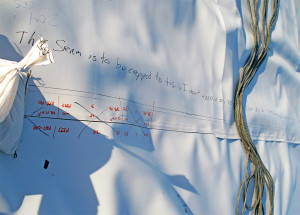Newton’s third law states that forces exist in pairs such that the forces are equal and opposite.
Take for instance the person sitting in their office chair reading this blog—that person has the downward force of their body resisted by the upward force of the chair. Some of the most successful projects I have been a part of use a similar principal in the relationship between the CQA team and the geosynthetics installation team, meaning there needs to be a healthy push and pull relationship between the two for the betterment of the project.
On one job as lead CQA technician, my responsibilities included on-site testing of seam destructive samples in a field laboratory. While getting ready to leave the construction area and head to the lab trailer, I noticed a fusion welder/operator struggling throughout most of the portion of a tie-in seam several hundred feet long. Areas of the seam were marked for cap by the operator, and air testing followed immediately behind with several more “to be capped” areas marked. Prior to my departure, I rushed over to mark destructive samples on both ends of this seam adjacent to the locations sampled by the installer for end coupon testing.
At the end of the shift, the CQA team informed me that the installation supervisor was upset at my destruct locations on the tie-in seam and he then cut the overlap (so the outside track could not be tested), crossed them out and left me the following kind note written on the liner: “This seam is to be capped to tie-in. I don’t need a DS to tell me that it is bad. I have end bones to tell me that.”
I immediately went over to the installation supervisor to find out what was wrong. He informed me that several end coupons on the seam failed and therefore he did not need a destruct taken to know his seam was bad, and that he planned on cutting the seam out and capping it. I was perfectly fine with his answer and explanation. I agreed with him that the destructs were not needed and were premature on my part because I was unaware of the results of the end coupons.
The desire for a quality project was the motivator for both of us, and sometimes you get pushed to the brink and make hasty decisions. Being unaware of the end coupon results, but seeing the air tests being performed was a visual indicator to me that the seam was likely to stay and therefore I needed to sample it to verify quality, and for the efficiency of both teams, I marked the samples promptly. To the installation supervisor, my marking destructs on a seam he knew was suspect were deemed unnecessary and ridiculous. The lack of communication between us probably could have avoided the whole issue, but we were in separate areas of the project, unaware of what each other was doing in regards to this same seam.
In the moment, either of us could have been perceived as acting as if an apple hit us in the head! The important thing was the communication that followed after this incident, as the relationship was mended and the quality of the project remained sound. Everything worked out fine and the project was a huge success.
Equally important was the tailgate meeting the next day in which we shared this experience and showed our ability to laugh at the incident—this sent the message to members of all teams that it was strictly a misunderstanding and that I was not on a “witch hunt” against the installation crew and that I was not upset with the installation supervisor. As the leaders of your crew, people are always watching and reacting to the things you do! A crew member perceiving the wrong message can be disastrous to the productivity on either side.
Years later, whenever the two of us from the above incident see each other or talk, we always have a laugh about the picture I shared. In the heat of the battle, even incidents that afterward seem nearly comical are usually very stressful. What incidents have you gone through? How have you successfully diffused situations that could have spiraled out of control?




